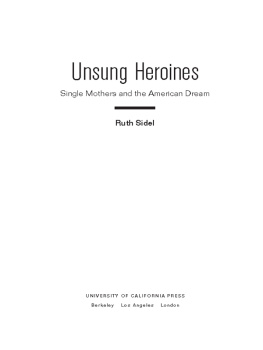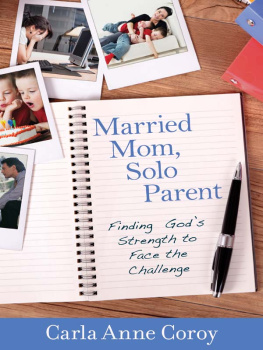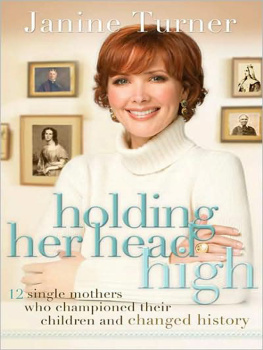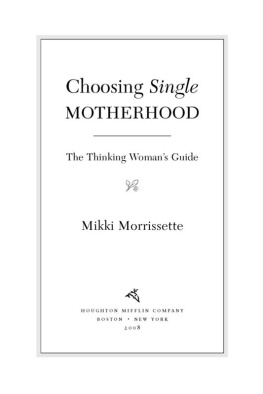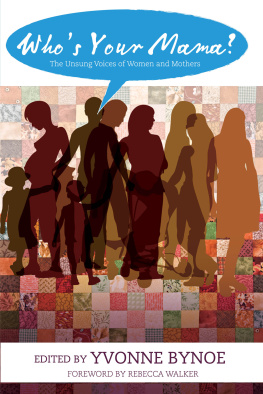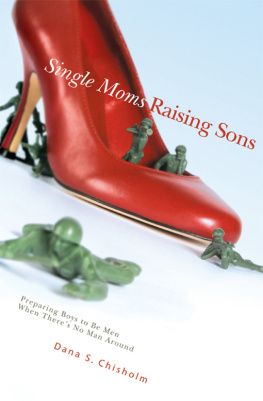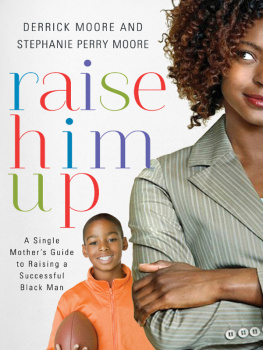Praise for Unsung Heroines
This pioneering new study by Ruth Sidel is an education for the nation. Sidel shatters all the old familiar negative myths and harsh stereotypes about single mothers, and gives us instead the unvarnished truth about their diverse lives, their courageous struggles to raise their children, and their genuine family valuesvalues they share with millions of other Americans. Many of the larger patterns Sidel identifiesthe constant search for a fair balance between work and family, the endless quest for decent jobs and fair pay and good schools and affordable health careapply to all families as well. Hopefully, this excellent and eloquent volume will act as a wake-up call, and wiser federal, state, and local policies will enable many, many more of these hard-working mothers to find light at the end of the tunnel. This book offers a unique opportunity for every reader to walk in the shoes of single mothers and help find that light.
SENATOR EDWARD M. KENNEDY
The publisher gratefully acknowledges the generous contribution to this book provided by the General Endowment Fund of the University of California Press Foundation
University of California Press, one of the most distinguished university presses in the United States, enriches lives around the world by advancing scholarship in the humanities, social sciences, and natural sciences. Its activities are supported by the UC Press Foundation and by philanthropic contributions from individuals and institutions. For more information, visit www.ucpress.edu.
University of California Press
Berkeley and Los Angeles, California
University of California Press, Ltd.
London, England
2006 by The Regents of the University of California
Library of Congress Cataloging-in-Publication Data
Sidel, Ruth.
Unsung heroines : single mothers and the American
dream / Ruth Sidel.
p. cm.
Includes bibliographical references and index.
ISBN 0-520-23826-5 (alk. paper).
ISBN 0-520-24772-8 (pbk. : alk. paper)
1. Single mothersUnited StatesSocial conditions. 2. Single mothersUnited StatesEconomic conditions. 3. Welfare recipientsUnited States. I. Title.
HQ759.915.S159 2006
306.874'32'086942'0973dc22 2005016915
Manufactured in the United States of America
14 13 12 11 10 09 08 07 06
10 9 8 7 6 5 4 3 2 1
The paper used in this publication meets the minimum requirements of ANSI/NISO Z39.481992 (R 1997) (Permanence of Paper).
For Marilyn
a true heroine and a constant inspiration
and
for Rosie, Thea, and Andy
who are already helping to make this a better world
As our case is new, so we must think anew, and act anew.
Abraham Lincoln
Second Annual Message to Congress
November 1, 1862
Acknowledgments
T o the wonderful women who were willing to share their thoughts, their feelings, and the story of their lives for this book, my deep gratitude. Their courage, warmth, generosity, and concern about the well-being of others are a true inspiration.
To Lynn Chancer, my profound appreciation for her enthusiasm for this project from the outset, her unflagging encouragement, her insight and wisdom, and, above all, her friendship. To Naomi Chase, Laurie Kramer, and Mindy Werner, my special thanks for reading part or all of the manuscript when it was in various stages of preparation and for giving me perceptive and invaluable suggestions. And to Kevin Sidel, who made cogent comments on the entire manuscript, my gratitude and my love.
To Vivyan Adair, Alice Axelbank, Aiyoung Choi, CarolAnn Daniel, Frances Falk Dickler, Dorothy Epstein, Sarah Greenblatt, Jerome Grossman, Steven Grossman, Margot Haas, Shawn Howard, Marilyn Jackson, Debi Sunhea Kim, Melinda Lackey, Suzanne Michael, Mary Murphree, Camille Murphy, Victor Perez, Janet Poppendieck, Margaret Raymond, Inge Sidel, Mark Sidel, Barbara Steed, ElizabethTemkin, and Maria Terrone, my appreciation for their interest in the topic, their referrals to single mothers, and particularly for their warm wishes and support.
To my editor, Naomi Schneider, who reminded me to write the book I really wanted to write and gave me superb advice on how to do it, my admiration and appreciation. To Dore Brown, Sierra Filucci, Hillary Hansen, Barbara Roos, and particularly to Alice Falk, my thanks for their creative and painstaking work on all aspects of the book.
And finally, to Vic, computer maven and all-round advisor extraordinaire, my love and gratitude for all you do and all you are.
Introduction

T he denigration and demonization of single mothers has deep roots in American culture. Mothers without husbands have been looked upon with suspicion and hostility since the time of the earliest settlers. Today's concerns about the weakening of the traditional family and about related issues such as single motherhood, divorce, sexual permissiveness, teenage pregnancy, and abortion have formed a central theme in American society for generations. Both the early Settlement Laws and the Colonial Poor Laws of seventeenth-century America punished husbandless women and unwed mothers, differentiating between the deserving and the undeserving. During the early years of the twentieth century, programs to help the poor stated that only fit and worthy women would receive help; these generally were white widows.
The recent period of intensified concern about single motherhood was spurred by the ascendancy of conservative ideology in the United States as marked by the election of Ronald Reagan as president. Rapid social change during the 1970s and 1980sincreasing numbers of single mothers, especially women having children outside marriage; a significant increase in teenage pregnancy and birth; a continuing high divorce rate; and fundamental changes in the roles and status of womencontributed to the anxiety about social issues. Reagan's infamous labeling of poor women as welfare queens was accompanied by significant cutbacks in essential social services, particularly for poor women and children. In the early 1980s Medicaid, Aid to Families with Dependent Children, the food stamp program, maternal and child health services, and day care were all slashed. These cutbacks increased the number of poor people and had a particularly devastating impact on female-headed families. Consequently, during this period there was a significant increase in both the feminization and the minoritization of poverty.
Since the early 1990s, single mothers have continued to be systematically stereotyped and stigmatized. Poor single mothers have once again been vilified as being lazy, irresponsible, dependent, deviant, and, above all, living off the hard work of others. Single mothers, particularly those who have children outside of marriage, have been blamed for virtually all the nation's social problemsthe breakdown of the family, the crime rate, drug and alcohol addiction, illiteracy, homelessness, poverty, and students' poor academic performance. Perhaps the most denigrating and dehumanizing attacks on single mothers occurred in 1995 on the floor of the U.S. House of Representatives when, as part of an effort to reduce the money spent on social welfare programs, two members of Congress compared welfare recipients to animals. This campaign was fueled by conservative Republicans, spearheaded by Newt Gingrich and buttressed by the work of the social scientist Charles Murray, who labeled out-of-wedlock births the single most important problem of our time as he railed against the culture of illegitimacy.
In 1992, the then vice president, Dan Quayle, set off a firestorm by condemning Murphy Brown, the central character in a popular television sitcom, for having a baby outside of marriage. Interestingly, during the episode in which Murphy Brown decided to have the baby, she debated between having an abortion and bearing a child. Quayle was surely not calling for her to terminate the pregnancy; he was clearly criticizing her for not being married before becoming pregnant. In the same speech, Quayle also suggested that unmarried women with children were at least partially responsible for the lawless social anarchy that erupted in the May 1992 riots in Los Angeles following the acquittal of the four police officers who brutally beat Rodney King. Several months later, an influential and widely read article by Barbara Dafoe Whitehead titled Dan Quayle Was Right was published in the

